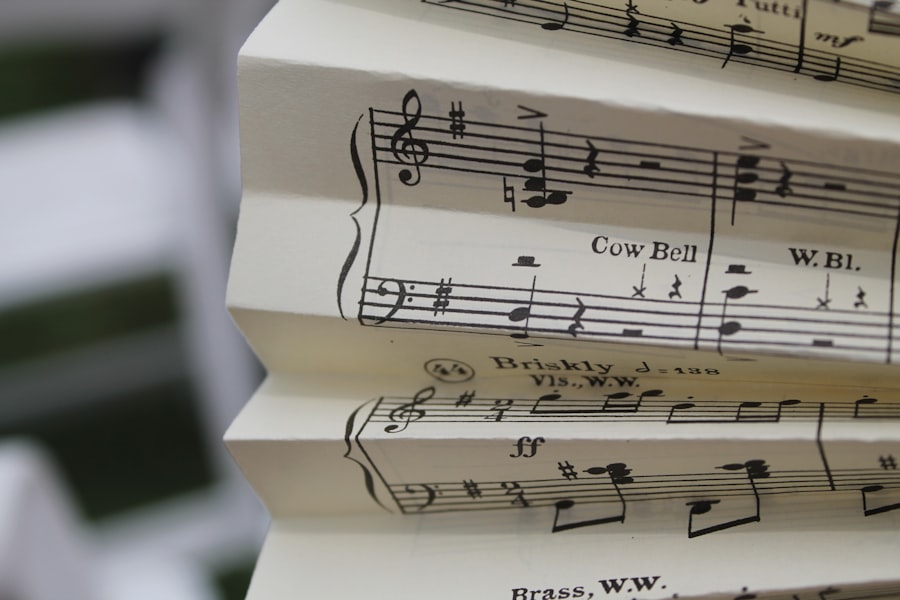Music serves as a powerful lens through which we can examine and understand historical contexts, societal changes, and cultural evolution. From the folk songs of the past to contemporary genres, music encapsulates the sentiments, struggles, and aspirations of different eras. For instance, the Civil Rights Movement in the United States was profoundly influenced by music, with songs like “We Shall Overcome” becoming anthems of hope and resilience.
These melodies not only provided comfort but also galvanized communities to rally for justice and equality. The lyrics often reflected the harsh realities faced by marginalized groups, serving as a historical document that captures the essence of their experiences. Moreover, music has the unique ability to transcend time and space, allowing us to connect with the emotions and thoughts of people from different periods.
The study of traditional music forms, such as the blues or Appalachian folk music, reveals insights into the lives of those who created them. For example, the blues emerged from African American communities in the Deep South, rooted in the experiences of slavery and oppression. The themes of loss, heartache, and resilience found in blues music provide a poignant commentary on the socio-political landscape of the time.
By analyzing these musical forms, historians can gain a deeper understanding of the cultural narratives that shaped societies and how those narratives continue to influence contemporary life.
Key Takeaways
- Music can serve as a powerful tool in uncovering and understanding historical events and cultural contexts.
- Paintings provide a visual representation of historical events and can offer insights into the social and political climate of the time.
- Place names can reveal the history and cultural influences of a particular region, shedding light on its past.
- Music reflects the cultural and historical context of a society, offering a unique perspective on the values and beliefs of a time period.
- Historical paintings play a significant role in helping us understand the past, offering a visual narrative of events and societal norms.
- Tracing the origins and meanings of place names can provide valuable insights into the history and cultural heritage of a specific location.
Exploring Historical Events Through Paintings
Paintings serve as visual narratives that capture significant historical events, offering a unique perspective that complements written records. Artists often respond to the world around them, creating works that reflect their interpretations of pivotal moments in history. For instance, Pablo Picasso’s “Guernica” is a powerful response to the bombing of the Basque town during the Spanish Civil War.
The chaotic composition and stark monochromatic palette convey the horror and suffering experienced by civilians, making it an enduring symbol of anti-war sentiment. Through such works, viewers can engage with history on an emotional level, experiencing the impact of events in a visceral way. Additionally, paintings can reveal societal values and cultural shifts over time.
The Renaissance period, for example, marked a significant transformation in artistic expression, characterized by a renewed interest in humanism and classical antiquity. Artists like Leonardo da Vinci and Michelangelo not only depicted religious themes but also explored human anatomy and emotion, reflecting a broader cultural movement towards individualism and scientific inquiry. By studying these artworks, historians can trace the evolution of thought and belief systems that defined entire epochs.
The visual language of paintings thus becomes a crucial tool for understanding how societies perceive themselves and their place in history.
Unraveling the Past Through Place Names

Place names are often overlooked as historical artifacts, yet they hold a wealth of information about cultural heritage, migration patterns, and historical events. The etymology of a place name can reveal its origins and significance within a particular context. For example, many cities in the United States bear names derived from Indigenous languages, reflecting the rich history of Native American tribes before European colonization.
Names like Chicago (from the Algonquin word “shikaakwa,” meaning “wild onion”) or Seattle (named after Chief Si’ahl) serve as reminders of the land’s original inhabitants and their connection to it. Furthermore, place names can also indicate historical events or figures that have shaped a region’s identity. In England, for instance, many towns have names that reference battles or significant occurrences.
The town of Hastings is forever linked to the pivotal Battle of Hastings in 1066, which marked the Norman Conquest of England. Such names not only commemorate events but also influence local culture and collective memory. By examining place names, historians can piece together narratives that highlight migration trends, territorial disputes, and cultural exchanges that have occurred over centuries.
How Music Reflects Cultural and Historical Context
The interplay between music and cultural context is profound; music often serves as both a reflection and a catalyst for social change. Genres evolve in response to societal shifts, capturing the zeitgeist of their times. For instance, punk rock emerged in the 1970s as a reaction against mainstream culture and political disillusionment.
Bands like The Sex Pistols and The Clash used their music to voice dissent against authority and societal norms, embodying the frustrations of a generation disenchanted with traditional values.
In addition to serving as a form of protest or expression, music can also act as a unifying force within communities.
Traditional folk music often reflects local customs and shared experiences, fostering a sense of belonging among its listeners. For example, Irish folk music has played a crucial role in preserving cultural identity among Irish communities worldwide. Songs passed down through generations tell stories of love, loss, migration, and resilience, connecting individuals to their heritage.
This cultural continuity is vital for maintaining communal ties and fostering pride in one’s roots. Thus, music becomes an essential vehicle for expressing collective identity while simultaneously documenting historical narratives.
The Significance of Historical Paintings in Understanding the Past
Historical paintings are invaluable resources for understanding past societies, as they encapsulate not only events but also the prevailing attitudes and beliefs of their time.
For instance, Édouard Manet’s “Olympia,” painted in 1863, challenged traditional representations of women in art by presenting a nude figure who gazes directly at the viewer with confidence rather than passivity.
This bold portrayal sparked controversy and dialogue about gender roles and sexuality during a period marked by strict social conventions. Moreover, historical paintings can serve as primary sources that provide insight into daily life during specific periods. Genre paintings from the Dutch Golden Age often depict scenes of domestic life or leisure activities, offering glimpses into social customs and economic conditions of 17th-century Netherlands.
Artists like Johannes Vermeer captured intimate moments that reveal not only aesthetic preferences but also social hierarchies and gender dynamics within households. By analyzing these works, historians can reconstruct aspects of daily life that might otherwise remain obscured in written records.
Tracing the Origins and Meanings of Place Names

The study of place names—toponymy—offers a fascinating glimpse into linguistic evolution and cultural history. Many place names derive from ancient languages that have since evolved or fallen out of use entirely. For example, many locations in Europe have names rooted in Latin or Celtic origins that reflect historical settlements or geographical features.
The name “London,” for instance, is believed to derive from the Latin “Londinium,” which was established by Roman settlers around AD 43. Such etymological explorations reveal not only linguistic transformations but also the layers of history embedded within geographical spaces. Additionally, place names can reflect significant historical events or figures that have shaped local identities.
In Australia, many towns bear names honoring Indigenous leaders or events significant to Aboriginal history. The name “Katherine,” for example, is derived from the local Aboriginal word “Goyder,” which refers to a nearby river significant to Indigenous communities long before European colonization. This practice of naming places after Indigenous heritage serves as an acknowledgment of their enduring connection to the land and highlights ongoing dialogues about reconciliation and recognition within contemporary society.
In conclusion, place names are more than mere labels; they are repositories of history that encapsulate stories of migration, conflict, and cultural exchange. By delving into their origins and meanings, we can uncover rich narratives that contribute to our understanding of both local identities and broader historical contexts.
In addition to uncovering history through music, painting, and place names, another interesting article on Yimho explores the topic of how to grow and care for ferns to create a lush green home. This article provides valuable tips and advice for maintaining these beautiful plants. Check it out here.
FAQs
What is the significance of uncovering history through music, painting, and place names?
Uncovering history through music, painting, and place names allows us to gain a deeper understanding of the cultural, social, and political contexts of different time periods and regions. It provides insight into the lives and experiences of people from the past and helps us appreciate the interconnectedness of history and art.
How does music help uncover history?
Music can serve as a reflection of historical events, societal values, and cultural traditions. By studying the music of a particular era or region, historians can gain insight into the emotions, struggles, and triumphs of the people who lived during that time. Additionally, music can provide clues about the influences and interactions between different cultures.
What role do paintings play in uncovering history?
Paintings offer visual representations of historical events, landscapes, and individuals. They can provide valuable information about the clothing, architecture, and customs of a specific time period. Additionally, paintings often convey the perspectives and ideologies of the artists, offering a unique window into the mindset of the society in which they lived.
How do place names contribute to uncovering history?
Place names can reveal the cultural, linguistic, and historical influences that have shaped a particular region. They may reflect the indigenous languages, colonial legacies, or significant events that have occurred in the area. By studying place names, historians can trace the migrations, settlements, and power dynamics that have shaped the geographical landscape.























+ There are no comments
Add yours